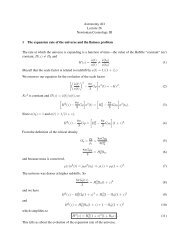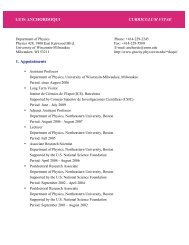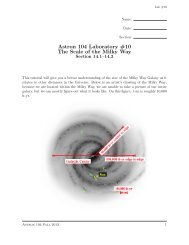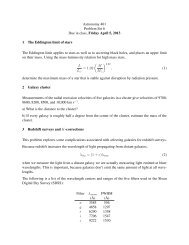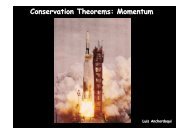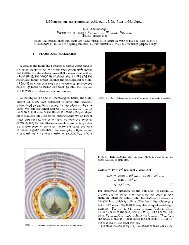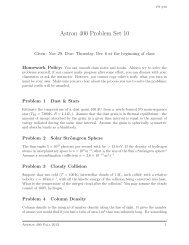Lecture I
Lecture I
Lecture I
You also want an ePaper? Increase the reach of your titles
YUMPU automatically turns print PDFs into web optimized ePapers that Google loves.
Physics 501<br />
Math Models of Physics Problems<br />
Wednesday, September 4, 13<br />
Luis Anchordoqui<br />
1
Bibliography<br />
L. A. Anchordoqui and T. C. Paul,<br />
``Mathematical Models of Physics Problems’‘<br />
(Nova Publishers, 2013)<br />
G. F. D. Duff and D. Naylor,<br />
``Differential Equations of Applied Mathematics’‘<br />
(John Wiley & Sons, 1966)<br />
G. B. Arfken, H. J. Weber, and F. E. Harris<br />
``Mathematical Methods for Physicists’’ (7th Edition)<br />
(Academic Press, 2012)<br />
Wednesday, September 4, 13<br />
2
Provisional Course Outline<br />
(Please note this may be revised during the course<br />
to match coverage of material during lectures, etc.)<br />
1st week - Elements of Linear Algebra<br />
2nd week - Analytic Functions<br />
3rd week - Integration in the Complex Plane<br />
4th week - Isolated Singularities and Residues<br />
5th week - Initial Value Problem (Picard’s Theorem)<br />
6th week -<br />
Initial Value Problem (Green Matrix)<br />
7th week - Boundary Value Problem (Sturm-Liouville Operator)<br />
8th week - Midterm-exam (October 23)<br />
9th week -<br />
Boundary Value Problem (Special Functions)<br />
10th week - Fourier Series and Fourier Transform<br />
11th week -<br />
Hyperbolic Partial Differential Equation (Wave equation)<br />
12th week - Parabolic Partial Differential Equation (Diffusion equation)<br />
13th week - Elliptic Partial Differential Equation (Laplace equation)<br />
14th week - Midterm-exam (December 11)<br />
Wednesday, September 4, 13<br />
3
Elements of Linear Algebra<br />
1.1 Linear Spaces<br />
1.2 Matrices and Linear Transformations<br />
Wednesday, September 4, 13<br />
4
Definition 1.1.1.<br />
field F<br />
+<br />
for which all axioms below hold 8 , µ, ⌫ 2 F :<br />
(i) closure + µ · µ<br />
A is a set together with two operations and<br />
sum and product again belong to F<br />
(ii) associative law +(µ + ⌫) =( + µ)+⌫ & · (µ · ⌫) =( · µ) · ⌫<br />
(iii) commutative law + ⌫ = ⌫ + & · µ = µ ·<br />
(iv) distributive laws · (µ + ⌫) = · µ + · ⌫<br />
and ( + µ) · ⌫ = · ⌫ + µ · ⌫<br />
(v) existence of an additive identity there exists an element<br />
0 2 F for which +0=<br />
(vi)<br />
Linear Spaces<br />
existence of a multiplicative identity<br />
1 2 F with 1 6= 0 for which 1 · =<br />
(vii) existence of additive inverse to every 2 F<br />
an additive inverse such that + =0<br />
there exists an element<br />
·<br />
there corresponds<br />
(viii) existence of multiplicative inverse to every 2 F<br />
1<br />
there corresponds a multiplicative inverse such that 1 · =1<br />
Wednesday, September 4, 13<br />
5
Example 1.1.1.<br />
Underlying every linear space<br />
is a field<br />
F<br />
examples are R<br />
and<br />
C<br />
Definition 1.1.2.<br />
A linear space<br />
V<br />
is a collection of objects<br />
with a (vector) addition and scalar multiplication defined<br />
which is closed under both operations<br />
Such a vector space satisfies following axioms:<br />
➢ commutative law of vector addition<br />
➢ associative law of vector addition<br />
➢ There exists a zero vector<br />
x + y = y + x, 8 x, y 2 V<br />
x +(y + w) =(x + y)+w, 8 x, y, w 2 V<br />
0<br />
such that<br />
x + 0 = x, 8 x 2 V<br />
Wednesday, September 4, 13<br />
6
➢ To every element<br />
x 2 V<br />
there corresponds an inverse element<br />
x<br />
such that<br />
x +( x) =0<br />
➢ associative law of scalar multiplication<br />
( µ) x = (µ x), 8 x 2 V and , µ 2 F<br />
➢ distributive laws of scalar multiplication<br />
( + µ) x = x + µ x, 8 x 2 V and , µ 2 F<br />
(x + y) = x + y, 8 x, y 2 V and 2 F<br />
➢<br />
1 · x = x, 8 x 2 V<br />
Wednesday, September 4, 13<br />
7
Example 1.1.2.<br />
Cartesian space<br />
R n<br />
is prototypical example<br />
of real<br />
n<br />
-dimensional vector space<br />
Let x =(x 1 ,...,x n ) be an ordered n tuple of real numbers x i<br />
to which there corresponds a point<br />
x<br />
with these Cartesian<br />
coordinates and a vector<br />
x<br />
with these components<br />
We define addition of vectors by component addition<br />
x + y =(x 1 + y 1 ,...,x n + y n )<br />
(1.1.1.)<br />
and scalar multiplication by component multiplication<br />
x =( x 1 ,..., x n )<br />
(1.1.2.)<br />
Wednesday, September 4, 13<br />
8
Definition 1.1.3.<br />
Given a vector space V over a field F<br />
W<br />
if<br />
W<br />
is vector space over F<br />
Corollary 1.1.1<br />
V<br />
a subset of is called subspace<br />
under operations already<br />
A subset W of a vector space V is a subspace of V ,<br />
defined on<br />
(i)W is nonempty (ii) if x, y 2 W ☛ then x + y 2 W<br />
(iii) x 2 W and 2 F ☛ then · x 2 W<br />
V<br />
After defining notions of vector spaces and subspaces<br />
next step is to identify functions that can be used<br />
to relate one<br />
vector space to another<br />
Functions should respect algebraic structure of vector spaces<br />
so we require they preserve addition<br />
and scalar multiplication<br />
Wednesday, September 4, 13<br />
9
Definition 1.1.4.<br />
Let V and W be vector spaces over field F<br />
A linear transformation from V<br />
to<br />
W<br />
is a function T : V ! W<br />
such that T ( x + µy) = T (x)+µT (y) (1.1.3.)<br />
for all vectors x, y 2 V and all scalars , µ 2 F<br />
If a linear transformation is one-to-one and onto<br />
it is called vector space isomorphism ☛ or simply isomorphism<br />
Definition 1.1.5.<br />
S = x 1 , ··· , x n<br />
Let be a set of vectors in vector space over field<br />
Any vector of form y =<br />
nX<br />
i=1<br />
is called linear<br />
ix i for i 2 F<br />
combination of vectors in<br />
V<br />
S<br />
F<br />
S<br />
Set is said to span if each element of<br />
Wednesday, September 4, 13<br />
V<br />
can be expressed as linear combination of vectors in<br />
V<br />
S<br />
10
Definition 1.1.6.<br />
Let be given vectors<br />
and<br />
m<br />
1,... m an equal<br />
number of scalars<br />
x 1 ,...,x m<br />
1x 1 + ···+ k x k + ···+ m x m<br />
We can form a linear combination or sum<br />
(1.1.4.)<br />
which is also an element of the vector space<br />
Suppose there exist values 1 ... n which are not all zero<br />
such that above vector sum is the zero vector<br />
Then the vectors x 1 ,...,x m<br />
are said to be linearly dependent<br />
Contrarily vectors x 1 ,...,x m are called linearly independent<br />
if<br />
1x 1 + ···+ k x k + ···+ m x m = 0<br />
(1.1.5.)<br />
demands scalars<br />
k must all be zero<br />
Wednesday, September 4, 13<br />
11
Definition 1.1.7<br />
Dimension of<br />
V<br />
Definition 1.1.8.<br />
V<br />
☛ maximal number of linearly independent vectors of<br />
n<br />
Let be an dimensional vector space<br />
and<br />
S = x 1 ,...,x n ⇢ V<br />
V<br />
(1.1.6.)<br />
a linearly independent spanning set for V<br />
➪<br />
S<br />
is called a basis of<br />
V<br />
Definition 1.1.9.<br />
Let<br />
S<br />
be a nonempty subset of vector space<br />
V<br />
➪ S is a basis for V if and only if each vector in V<br />
can be written uniquely as a linear combination of vectors in<br />
Wednesday, September 4, 13<br />
S<br />
12
Definition 1.1.10.<br />
An inner product<br />
(x, y)<br />
h , i : V ⇥ V ! F<br />
ordered pair of elements of<br />
and has following properties:<br />
➢ conjugate symmetry or Hermiticity<br />
➢ linearity in second argument<br />
➢ definiteness<br />
Corollary 1.1.2.<br />
is a function that takes each<br />
V<br />
to a number<br />
hx, yi 2F<br />
hx, yi =(hy, xi) ⇤<br />
hx, y + wi = hx, yi + hx, wi and hx, yi = hx, yi<br />
hx, xi =0, x = 0<br />
Conjugate symmetry and linearity in second variable gives<br />
h x, yi =(hy, xi) ⇤ = ⇤ (hy, xi) ⇤ = ⇤ (hx, yi)<br />
hy + w, xi =(hx, y + wi) ⇤ =(hx, yi) ⇤ +(hx, wi) ⇤ = hy, xi + hw, xi<br />
Remark 1.1.1.<br />
In R inner product is symmetric<br />
whereas in<br />
C<br />
is a sesquilinear form<br />
(i.e. is linear in one argument and conjugate-linear in other)<br />
Wednesday, September 4, 13<br />
13
Definition 1.1.11.<br />
An inner product h , i is said to be positive definite ,<br />
for all non-zero x in V,hx, xi 0<br />
A positive definite inner product is usually referred to as<br />
Definition 1.1.12.<br />
An inner product space is a vector space V<br />
equipped with an inner product h , i : V ⇥ V ! F<br />
Definition 1.1.13.<br />
V<br />
F<br />
over field<br />
Vector space on endowed with a positive definite inner<br />
product (a.k.a. scalar product) defines Euclidean space E<br />
Example 1.1.3.<br />
For<br />
x, y 2 R n<br />
Example 1.1.4.<br />
nX<br />
hx, yi = x · y = x k y k<br />
For x, y 2 C n hx, yi = x · y =<br />
k=1<br />
(1.1.7.)<br />
nX<br />
x ⇤ ky k (1.1.8.)<br />
k=1<br />
genuine inner product<br />
Wednesday, September 4, 13<br />
14<br />
F
Example 1.1.5.<br />
C([a, b] )<br />
x(t)<br />
Let<br />
denote set of continuous functions<br />
defined on closed interval 1
Definition 1.1.14.<br />
Axiom of positivity allows one to define a norm or length<br />
For each vector of an euclidean space<br />
kxk =+ p hx, xi<br />
In particular kxk =0, x = 0<br />
Further ☛ if<br />
2 C<br />
k xk = p | | 2 hx, xi = | |kxk<br />
This allows a normalization for any non-zero length vector<br />
Indeed ☛ if x 6= 0 then kxk > 0<br />
Thus ☛ we can take 2 Csuch that | | = kxk 1 y = x<br />
and<br />
It follows that kyk = | |kxk =1<br />
Example 1.1.6.<br />
Length of a vector<br />
Example 1.1.7.<br />
x 2 R n is<br />
kxk =<br />
Length of a vector x 2C 2 ([a, b]) is<br />
|<br />
|xk =<br />
(1.1.12.)<br />
(1.1.13.)<br />
1/2 nX<br />
xk! 2 (1.1.14.)<br />
k=1<br />
( Z b<br />
|x(t)| 2 dt<br />
a<br />
) 1/2<br />
(1.1.15.)<br />
Wednesday, September 4, 13<br />
16
Definition 1.1.15.<br />
In a real Euclidean space angle between vectors<br />
x<br />
and<br />
y<br />
cos cxy =<br />
|hx, yi|<br />
kxkkyk<br />
(1.1.16.)<br />
Definition 1.1.16.<br />
Two vectors are orthogonal x y if hx, yi =0<br />
Zero vector is orthogonal to every vector in E<br />
Definition 1.1.17.<br />
In a real Euclidean space<br />
angle between two orthogonal non-zero vectors is<br />
⇡/2<br />
⤶<br />
i.e. cos cxy =0<br />
Wednesday, September 4, 13<br />
17
Lemma 1.1.1.<br />
If<br />
{x 1 , x 2 , ··· , x k } is a set of mutually orthogonal non-zero vectors<br />
Proof.<br />
Assume that vectors are linearly dependent<br />
Corollary 1.1.3.<br />
k<br />
then its elements are linearly independent<br />
Then ☛ there exists numbers i (not all zero) such that<br />
1x 1 + 2 x 2 + ···+ k x k = 0<br />
1 6= 0<br />
(1.1.17.)<br />
Further ☛ assume that and consider scalar product<br />
of the linear combination (1.1.17) with vector x 1<br />
Since<br />
x i x j<br />
or equivalently<br />
for i 6= j ☛ we have<br />
which contradicts hypothesis<br />
1hx 1 , x 1 i = hx 1 , 0i<br />
1kx 1 k 2 =0) x 1 = 0<br />
If a sum of mutually orthogonal vectors is<br />
Wednesday, September 4, 13<br />
0<br />
(1.1.18.)<br />
(1.1.19.)<br />
then each vector must be<br />
0<br />
18
Definition 1.1.18.<br />
A basis<br />
x 1 ,...,x n of<br />
V<br />
is called orthogonal<br />
if<br />
hx i , x j i =0<br />
for all<br />
i 6= j<br />
☛ basis is called orthonormal<br />
Example 1.1.8.<br />
kx i k =1, 8i =1,...,n<br />
unit length<br />
Simplest example of an orthonormal basis is standard basis<br />
e 1 =<br />
0<br />
B<br />
@<br />
1<br />
0<br />
0<br />
.<br />
0<br />
0<br />
1<br />
, e 2 =<br />
C<br />
A<br />
if in addition each vector has<br />
0<br />
B<br />
@<br />
0<br />
1<br />
0<br />
.<br />
0<br />
0<br />
1<br />
, ... e n =<br />
C<br />
A<br />
0<br />
B<br />
@<br />
0<br />
0<br />
0<br />
.<br />
0<br />
1<br />
1<br />
C<br />
A<br />
(1.1.20.)<br />
Wednesday, September 4, 13<br />
19
Lemma 1.1.2.<br />
If set of vectors {x 1 , x 2 , ··· , x k }<br />
* +<br />
kX<br />
kX<br />
y, ix i =<br />
i=1<br />
i=1<br />
Theorem 1.1.1. (Pythagorean theorem)<br />
If<br />
then every<br />
y 2E<br />
is orthogonal to<br />
linear combination of this set of vectors<br />
ihy, x i i (1.1.22.)<br />
x y 2E then<br />
kx + yk 2 = hx + y, x + yi = kxk 2 + kyk 2 (1.1.23.)<br />
In any right triangle ☛ area of square whose side is hypotenuse<br />
(side opposite right angle) is equal to sum of areas of squares<br />
whose sides are two legs (two sides that meet at a right angle)<br />
Corollary 1.1.4.<br />
is also orthogonal to<br />
If set of vectors {x 1 , x 2 , ··· , x k } are mutually orthogonal<br />
y<br />
x i x j with i 6= j then<br />
(1.1.24.)<br />
Wednesday, September 4, 13<br />
||x 1 + ···+ x k || 2 = ||x 1 || 2 + ···+ ||x k || 2 20
Corollary 1.1.5. (Triangle inequality)<br />
For<br />
x, y 2E we have<br />
kxk<br />
kyk applekx + yk applekxk + kyk<br />
(1.1.25.)<br />
Length of a side of a triangle<br />
does not exceed sum of lengths of other two sides<br />
nor is it less than absolute value of difference of other two sides<br />
Proof.<br />
Consider scalar product<br />
kx + yk 2 = hx + y, x + yi = kxk 2 +2
Definition 1.1.19.<br />
Let<br />
x =(x 1 ,...,x k ,...)<br />
be an infinite sequence of real numbers<br />
such that<br />
1X<br />
k=1<br />
x 2 k converges<br />
Sequence x defines a point of Hilbert coordinate space<br />
It also defines a vector with<br />
which as in<br />
Addition and scalar multiplication<br />
x<br />
k<br />
with<br />
k<br />
-th component x k<br />
-th coordinate<br />
Norm of Hilbert vector is Pythagorean expression<br />
! 1/2<br />
1X<br />
kxk =<br />
By hypothesis<br />
this series converges if<br />
k=1<br />
x 2 k<br />
R n<br />
R 1<br />
x k<br />
we identify with point<br />
are defined analogously to (1.1.1) and (1.1.2)<br />
x is an element of Hilbert space H = E 1<br />
Wednesday, September 4, 13<br />
22
Definition 1.2.0<br />
Definition 1.2.1.<br />
Linear Operators on Euclidean Spaces<br />
An operator A on E is a vector function A : E!E<br />
Operator is called linear if<br />
A(↵x + y) =↵Ax + Ay, 8x, y 2E and 8↵, 2 C (or R)<br />
A n ⇥ n x<br />
T (x) =Ax<br />
Let be an<br />
matrix and a vector<br />
➪<br />
A vector<br />
the function<br />
Definition 1.2.2.<br />
is a linear operator<br />
x 6= 0 is eigenvector of A if 9 satisfying A x = x<br />
in such a case (A I) x = 0 ☛ I is identity matrix<br />
Eigenvalues are given by relation det (A I) =0<br />
which has<br />
➪<br />
m<br />
different roots with<br />
1 apple m apple n<br />
det(A I) is a polynomial of degree n<br />
Eigenvectors associated with eigenvalue<br />
are obtained by<br />
solving (singular) linear system (A I) x = 0<br />
Wednesday, September 4, 13<br />
23
Remark 1.2.1.<br />
x 1 x 2 a, b constants<br />
ax 1 + bx 2 is an eigenvector with eigenvalue because<br />
If and are eigenvectors with eigenvalue and<br />
➪<br />
A(ax 1 + bx 2 )=aAx 1 + bAx 2 = a x 1 + b x 2 = (ax 1 + bx 2 )<br />
It is straightforward to show that:<br />
(i) eigenvectors associated to a given eigenvalue<br />
form a vector space<br />
(ii) two eigenvectors corresponding to different eigenvalues<br />
are lineraly independent<br />
Definition 1.2.3.<br />
A matrix is said to be diagonable (or diagonalizable)<br />
if the eigenvectors form a base<br />
i.e. if any vector v can be written as a linear combination<br />
of eigenvectors<br />
A matrix<br />
A<br />
A<br />
is said to be diagonable<br />
if there exists n eigenvectors<br />
that are linearly independent<br />
x 1 ,...,x n<br />
Wednesday, September 4, 13<br />
24
In such a case<br />
☛<br />
we can form with<br />
k<br />
n eigenvectors an n ⇥ n matrix U<br />
U<br />
such that -th column of is -th eigenvector<br />
In this way<br />
☛ relations<br />
can be written in a matrix form<br />
U<br />
n Ax k = x k<br />
AU = UA 0 ☛ A 0 is a n ⇥ n<br />
The latter can also be written as<br />
U 1 AU= A 0 , or equivalently A = UA 0 U 1 ,<br />
k<br />
diagonal matrix such that<br />
A 0 ij =<br />
i ij<br />
which bind diagonal matrix with original matrix<br />
( is invertible because eigenvectors are linearly independent)<br />
Definition 1.2.4.<br />
Transformation (1.2.11.) represents a change of base<br />
Note that eigenvalues (and therefore matrix A 0 )<br />
are independent of change of base<br />
n ⇥ n<br />
if B = W 1 AW with W an arbitrary (invertible)<br />
➪ det (B I) =det(W 1 AW W 1 W)=det(A I)<br />
Wednesday, September 4, 13<br />
such that it has same eigenvalues<br />
(1.2.11.)<br />
matrix<br />
(1.2.12.)<br />
25
Definition 1.2.5.<br />
If real function<br />
f(x)<br />
f(x) =<br />
has a Taylor expansion<br />
1X<br />
f (n) (0)<br />
n!<br />
x n (1.2.13.)<br />
n=0<br />
matrix function is defined by substituting argument<br />
powers become matrix powers, additions become matrix sums<br />
and multiplications become scaling operations<br />
If real series converges for |x|
Definition 1.2.6.<br />
A complex square matrix A is Hermitian if A = A †<br />
where A † =(A ⇤ ) T<br />
Remark 1.2.2.<br />
It is easily seen that if<br />
is conjugate transpose of a complex matrix<br />
A<br />
(i) its eigenvalues are real<br />
A partially defined linear operator<br />
is Hermitian then:<br />
(ii) eigenvectors associated to different eingenvalues<br />
are orthogonal<br />
(iii) it has a complete set of orthogonal eigenvectors<br />
which makes it diagonalizable<br />
Definition 1.2.7.<br />
A<br />
on a Hilbert space<br />
is called symmetric if hAx, yi = hx,Ayi, 8 x and y in domain of A<br />
A symmetric everywhere defined operator is called<br />
self-adjoint or Hermitian<br />
H<br />
on this Hilbert space we have ☛<br />
H<br />
C n A<br />
hx, Ayi = hAx, yi, 8 x, y 2 C n<br />
Note that if we take as Hilbert space<br />
with standard dot product<br />
and interpret a Hermitian square matrix as a linear operator<br />
Wednesday, September 4, 13<br />
27
Example 1.2.1<br />
A convenient basis for traceless Hermitian<br />
are Pauli matrices:<br />
1 =<br />
They obey following relations:<br />
(i)<br />
✓ 0 1<br />
1 0<br />
2<br />
i = I<br />
(ii) i j = j i<br />
(iii) i j = i k<br />
(i, j, k)<br />
◆ ✓ 0 i<br />
, 2 =<br />
i 0<br />
◆<br />
, 3 =<br />
☛ a cyclic permutation of (1,2,3)<br />
These three relations can be summarized as<br />
2 ⇥ 2 matrices<br />
✓ 1 0<br />
0 1<br />
◆<br />
(1.1.36.)<br />
☛<br />
✏ ijk<br />
i j = I ij + i✏ ijk k (1.1.37.)<br />
is Levi-Civita symbol<br />
Wednesday, September 4, 13<br />
28
Wednesday, September 4, 13<br />
29





